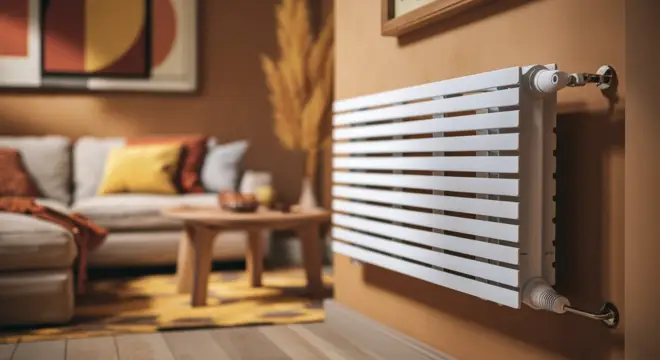The Ultimate Guide to Oil-Filled Radiators: Safe, Efficient, and Cost-Effective Heating?
Are you hunting for the heating that is going to be most effective and safe at home? The drop in temperature makes it necessary to find a heater for comfort and well-being within the family. With many types of heaters available in the market, one has oil-filled radiators that are commonly used for efficiency and safe. So, what is the actual check- they provide security and dependability in regard to heating?
In this article, we’ll explore why oil-filled radiators are considered one of the safest and most reliable heating options. From protecting kids and pets to offering energy-efficient warmth, we’ll help you decide if this heater is the best choice for your home this winter.
How Do Oil-Filled Radiators Work?
Oil-filled radiators are a popular choice for home heating due to their unique mechanism, which ensures efficient and steady warmth. Here’s how they work:
1. Internal Heating Mechanism
This is an oil-filled radiator. Its heating element is immersed in a special heat-conductive oil. Thus, when the radiator is switched on, electric current will flow into the heating element making it hot and in turn warming the oil that is sealed in the unit.
2. Heat Retention and Radiation
It is a heat-storing oil which retains heat well and remains warm for a long time even after switching the radiator off. This heat is slowly transferred to the metal fins of the radiator, thus radiating warmth uniformly into the room. Thus, it does not have those sudden bursts that other heaters give.
3. No Oil Replacement Needed
One of the most common misconceptions regarding oil-filled radiator heating devices is that the oil inside has to be replaced. This is a false assertion since the oil is sealed in the device permanently and is only used in transfer of heat, meaning it does not burn or evaporate.
4. Comparison to Other Heaters
- Fan Heaters: Fan heaters provide quick warmth by blowing hot air into the room. However, they tend to dry out the air and are less energy-efficient because they don’t retain heat once turned off. In contrast, oil-filled radiators provide a more consistent and long-lasting warmth.
- Ceramic Heaters: Ceramic heaters heat up quickly and are compact, but they’re less effective for heating large spaces compared to oil-filled radiators. Additionally, oil-filled radiators distribute heat more evenly.
- Infrared Heaters: Infrared heaters directly heat objects and people in their path, but they don’t warm up the air, making them less suitable for whole-room heating compared to oil-filled radiators.
Why Are Oil-Filled Radiators Considered Safe?
Safety is one of the biggest factors homeowners consider when choosing a heater, and oil-filled radiators are often regarded as among the safest options. Here’s why:
1. Key Safety Features
- No Exposed Heating Elements
- Unlike fan or coil heaters that use exposed heating elements, oil-filled radiators have a fully enclosed system. This eliminates the risk of direct contact with hot components, making them ideal for homes with kids and pets.
- Overheat Protection and Tip-Over Switches
- Modern oil-filled radiators come equipped with built-in safety mechanisms. If the unit overheats or gets accidentally tipped over, it will automatically shut off to prevent any accidents or fire hazards.
- Silent Operation with No Moving Parts
- These radiators are noiseless because they don’t use fans or other mechanical components to circulate heat. This makes them safe to use in bedrooms, especially for light sleepers, while also minimizing the risk of malfunction caused by moving parts.
2. User Concerns Debunked
- No Risk of Oil Spillage
- One common worry is whether the oil inside the radiator could leak. The oil is permanently sealed within the unit and never comes into contact with the air, ensuring there’s no risk of spillage or evaporation.
- Low Surface Temperature Compared to Electric Heaters
- Although the metal surface of the radiator gets warm, it doesn’t reach the extreme temperatures seen in coil or fan heaters. This significantly reduces the chances of burns, even if someone accidentally touches it.
3. Safety Certifications to Look For
When purchasing an oil-filled radiator, look for safety certifications such as:
- CE (Conformité Européenne): Ensures compliance with EU safety standards.
- UL (Underwriters Laboratories): Indicates the product meets U.S. and Canadian safety standards.
- RoHS (Restriction of Hazardous Substances): Confirms that the unit is free from harmful substances like lead or mercury.

Safety in Different Scenarios
Oil-filled radiators are designed with safety in mind, making them an excellent choice for households with unique needs. Let’s explore how they perform in specific scenarios:
1. Homes with Children and Pets
Children and pets are naturally curious, and the safety of heating devices around them is a major concern. Oil-filled radiators excel in this area for several reasons:
- Reduced Risk of Burns: The radiator’s surface gets warm but doesn’t reach the high temperatures of exposed heating elements in fan or coil heaters. This reduces the likelihood of burns if a child or pet brushes against it.
- Stable Design: Many models have wide bases and anti-tip mechanisms, preventing them from being easily knocked over.
- Enclosed System: Since there are no open flames or exposed components, kids and pets can move freely around the radiator without danger.
2. Suitable for Elderly Individuals
For elderly individuals, safety and comfort are critical. Oil-filled radiators provide even, gentle warmth, which is particularly suitable for those with respiratory issues or sensitive skin:
- No Dry Air or Allergens: Unlike fan heaters, which circulate hot, dry air and can stir up dust, oil-filled radiators heat the room passively. This makes them ideal for people with asthma, allergies, or other lung sensitivities.
- Consistent Heating: The heat retention property of oil ensures that the room remains warm even after the heater is turned off, preventing sudden temperature drops.
- Easy Controls: Many models come with large, user-friendly dials or remote controls, making it convenient for elderly users to adjust the settings.
3. Overnight Use
Oil-filled radiators are particularly safe for use during the night, offering worry-free warmth while you sleep:
- Built-In Thermostats: These allow the radiator to maintain a consistent temperature, preventing overheating and conserving energy.
- Timers for Automatic Shutoff: Many models come with programmable timers, so the heater can turn off after a set duration, ensuring safety and energy efficiency.
- Silent Operation: With no fans or moving parts, oil-filled radiators operate quietly, making them perfect for bedrooms or nurseries.
Comparing Oil-Filled Radiators to Other Heating Options
When it comes to heating your home, various options are available, each with its advantages and drawbacks. Let’s compare oil-filled radiators to other common heating alternatives to understand their place in the market.
1. Fan Heaters
Advantages:
- Fan heaters are known for their rapid heating, making them ideal for quickly warming up small spaces.
- They are lightweight, portable, and often less expensive upfront.
Drawbacks:
- Safety Concerns: The exposed heating elements in fan heaters pose a higher risk of fire and burns, especially in households with kids or pets.
- Dry Air: By blowing hot air, fan heaters can dry out the room, causing discomfort for people with sensitive skin or respiratory issues.
- Energy Efficiency: They only provide warmth as long as they are on, with little to no residual heat after being switched off.
Comparison: Oil-filled radiators provide a safer, quieter, and more energy-efficient solution, especially for prolonged use.
2. Ceramic Heaters
Advantages:
- Ceramic heaters are compact and powerful, capable of heating small to medium-sized spaces quickly.
- Many models feature adjustable fans for better heat distribution.
Drawbacks:
- Prolonged Use: Ceramic heaters are less effective for sustained heating over several hours and can consume significant electricity.
- Safety: Though safer than fan heaters, the surface can still become hot, posing a risk of burns.
Comparison: Oil-filled radiators distribute heat more evenly and retain warmth longer after being turned off, making them more cost-effective and safer for extended use.
3. Infrared Heaters
Advantages:
- Infrared heaters are highly energy-efficient, as they directly heat objects and people rather than the surrounding air.
- They work well in specific zones and are perfect for outdoor spaces like patios.
Drawbacks:
- Limited Coverage: Infrared heaters don’t warm the entire room, making them less suitable for general home heating.
- No Heat Retention: The warmth dissipates quickly once the heater is turned off.
Comparison: Oil-filled radiators provide a broader, more uniform heat distribution and are better suited for whole-room heating.
4. Central Heating
Advantages:
- Central heating systems offer whole-home heating, ensuring consistent warmth throughout multiple rooms.
- They are often more energy-efficient in the long term, particularly for larger homes.
Drawbacks:
- High Upfront Costs: Installing or upgrading a central heating system can be expensive.
- Maintenance: Requires regular servicing to keep it running efficiently.
- Flexibility: Central heating lacks the portability of standalone heaters like oil-filled radiators.
Comparison: Oil-filled radiators are a cost-effective alternative for targeted heating in individual rooms, especially for renters or those without central heating.
Energy Efficiency and Costs
When selecting a heater, understanding energy efficiency and operating costs is essential. Oil-filled radiators are known for their ability to provide consistent heat while being relatively economical to run. Here’s how they compare and how to optimize their use:
1. Cost of Running an Oil-Filled Radiator
Wattage Calculation:The cost of operating an oil-filled radiator depends on its wattage and the duration of use. For example:
- A standard 1500W oil-filled radiator running for 6 hours a day:
1.5kW×6hours=9kWh per day
- If electricity costs $0.15 per kWh, the daily cost would be:
9kWh×0.15=1.35USD per day
- Over a month, this adds up to about $40.50 for 6 hours of daily use.
Comparison with Other Heaters
- Fan heaters: Consume similar power but stop providing warmth immediately after being turned off, often leading to higher usage times.
- Infrared heaters: More energy-efficient for targeted heating but not ideal for whole-room heating, leading to uneven warmth.
- Ceramic heaters: Consume less power for small rooms but lack the heat retention of oil-filled radiators, resulting in higher operational frequency.
2. Longevity of Warmth After Turning It Off
One of the key advantages of oil-filled radiators is their ability to retain heat. The oil inside the unit stays warm for an extended period after the power is turned off, allowing the radiator to continue emitting heat without consuming additional electricity. This makes them more efficient for sustained heating compared to heaters that lose warmth instantly.
3. Tips to Save Energy
To maximize efficiency and reduce costs, consider these practical tips:
Use Thermostats and Timers: Many oil-filled radiators come with built-in thermostats and timers. Set the thermostat to maintain a consistent temperature and use the timer to limit usage to specific periods, like warming a room before bedtime.
Choose the Right Radiator Size: Selecting a model suited to your room size is crucial. Oversized radiators waste energy, while undersized ones will struggle to heat the space efficiently. Check the wattage guide:
- Small rooms (up to 150 sq ft): 700–1000W.
- Medium rooms (150–300 sq ft): 1000–1500W.
- Large rooms (300+ sq ft): 1500–2000W.
Place the Radiator Strategically: Position the radiator away from doors or windows to reduce heat loss.
Environmental and Maintenance Considerations
Oil-filled radiators are not just energy efficient and particularly safe, but they’re also proud green living and very low maintenance. So here’s a closer look at the environmental benefits of oil-filled radiators, as well as how to maintain them at their best.
1. Eco-Friendliness
- Lower Carbon Footprint: Oil-filled radiators are more energy-efficient than many other portable heaters, such as fan or coil heaters. They heat spaces gradually and retain warmth for longer, reducing the overall energy consumption. This lower energy use translates to a smaller carbon footprint, especially if powered by renewable electricity sources.
- Durable and Long-Lasting: Built to last, oil-filled radiators require minimal replacements or repairs. Their durability reduces the need for frequent manufacturing of new units, indirectly reducing waste and the environmental impact associated with production and disposal.
- No Harmful Emissions: Unlike gas heaters, oil-filled radiators don’t emit harmful gases such as carbon monoxide, making them a safer and greener choice for indoor use.
2. Maintenance Tips
To ensure your oil-filled radiator runs efficiently for years, follow these simple maintenance practices:
- Keeping It Clean: Dust and debris can accumulate on the radiator’s surface and fins, reducing its efficiency. Use a soft cloth or a vacuum with a brush attachment to clean it regularly.
- Ensure the radiator is unplugged and completely cool before cleaning.
- Check the Power Cord: Inspect the power cord for any signs of wear or damage. Frayed cords can pose safety risks and should be replaced immediately.
- Ventilation Matters: Avoid blocking the radiator’s vents or placing items directly on it, as this can cause overheating and reduce its efficiency.
3. Common Issues and How to Fix Them
1. Problem: Radiator Not Heating Properly
- Solution: Check the thermostat settings and ensure the power supply is functioning. If the issue persists, it may be a sign of an internal fault requiring professional repair.
2. Problem: Unusual Noises
- Solution: A slight clicking sound is normal as the radiator heats up or cools down. However, persistent loud noises may indicate an issue with internal components and should be inspected.
3. Problem: Surface Stains or Rust
- Solution: Wipe stains with a damp cloth. For rust, gently sand the area and apply a rust-resistant paint to prevent further corrosion.
Features to Look for When Buying an Oil-Filled Radiator
Choosing the right oil-filled radiator ensures you get the most value for your investment. Here are the essential and advanced features to consider, along with recommendations for different needs.
1. Essential Features
Adjustable Thermostat: Allows you to set and maintain your desired room temperature, reducing energy waste and ensuring consistent comfort. Look for models with precise digital or analog controls.
Timer Function: Timers let you schedule when the radiator turns on or off, saving energy by heating the room only when needed. This feature is especially useful for pre-warming a space before you wake up or return home.
Safety Switches: Look for models with built-in safety features like:
- Overheat Protection: Automatically shuts off the radiator if it gets too hot.
- Tip-Over Protection: Turns off the unit if it accidentally falls, making it safer for homes with kids or pets.
Portable Design: Many oil-filled radiators come with wheels or carrying handles, making it easy to move them between rooms. This adds flexibility, especially if you want to heat different areas of your home.
2. Advanced Features
- Smart Controls (Wi-Fi and Apps): Modern oil-filled radiators offer smart home compatibility, allowing you to control them remotely via smartphone apps. This is perfect for adjusting settings or turning the heater on/off while you’re away.
- Silent Modes: While oil-filled radiators are inherently quiet, some models offer enhanced silent modes that minimize operational noise, ideal for bedrooms or workspaces.
- Eco Modes: Some advanced models include an “Eco Mode” that optimizes energy usage by automatically adjusting the heat output based on room conditions.
3. Recommended Brands and Models
Here are a few popular options that cater to different needs:
For Budget Buyers:
- De’Longhi TRNS0505M: Compact and energy-efficient, great for small rooms.
For Smart Homes:
- De’Longhi Dragon 4 Pro: Features Wi-Fi connectivity and app control.
For Large Rooms:
- Dimplex OFRC20TiN: High wattage and efficient heat distribution for larger spaces.
For Silent Operation:
- Mill Oil Premium 1500W: Known for its ultra-quiet performance.
FAQs
1. Can It Be Left Overnight?
Yes, oil-filled radiators are safe to use overnight, provided they are equipped with safety features like an overheat protection switch and a tip-over shutoff. Many models also have built-in timers and thermostats to maintain a consistent temperature and prevent overheating. As a precaution, ensure the radiator is placed on a flat, stable surface and away from flammable materials.
2. Is It Safe for Asthmatics?
Absolutely. Oil-filled radiators are an excellent choice for people with asthma or respiratory sensitivities. Unlike fan heaters, they don’t circulate air, dust, or allergens around the room. Instead, they radiate gentle, even warmth, making them a healthier option for maintaining indoor air quality
3. Do They Consume a Lot of Electricity?
Oil-filled radiators are relatively energy-efficient compared to other portable heaters. While the electricity consumption depends on the wattage and usage duration, their heat retention helps reduce overall energy costs. For example, a 1500W radiator used for 6 hours a day costs approximately $1.35 per day (at $0.15/kWh). Using features like timers and thermostats further optimizes energy usage, making them cost-effective for prolonged use.
4. Does the Oil Ever Need Replacing?
No, the oil inside an oil-filled radiator is permanently sealed and does not burn, evaporate, or degrade over time. The oil is used solely to transfer and retain heat, so it never needs to be refilled or replaced. If the radiator leaks oil, it’s a rare defect that would require professional repair or replacement of the unit.


